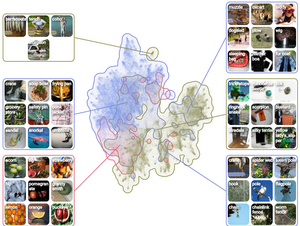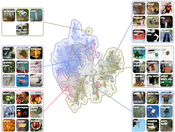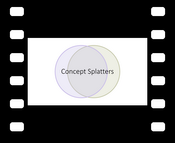Information
- Publication Type: Journal Paper (without talk)
- Workgroup(s)/Project(s):
- Date: April 2022
- DOI: 10.1016/j.cag.2022.04.013
- ISSN: 1873-7684
- Journal: Computers and Graphics
- Open Access: yes
- Pages: 12
- Volume: 105
- Publisher: Elsevier
- Pages: 73 – 84
- Keywords: Concept spaces, Latent spaces, Similarity maps, Visual exploratory analysis
Abstract
Similarity maps show dimensionality-reduced activation vectors of a high number of data points and thereby can help to understand which features a neural network has learned from the data. However, similarity maps have severely limited expressiveness for large datasets with hundreds of thousands of data instances and thousands of labels, such as ImageNet or word2vec. In this work, we present “concept splatters” as a scalable method to interactively explore similarities between data instances as learned by the machine through the lens of human-understandable semantics. Our approach enables interactive exploration of large latent spaces on multiple levels of abstraction. We present a web-based implementation that supports interactive exploration of tens of thousands of word vectors of word2vec and CNN feature vectors of ImageNet. In a qualitative study, users could effectively discover spurious learning strategies of the network, ambiguous labels, and could characterize reasons for potential confusion.Additional Files and Images
Weblinks
- paper
Link to open access paper - online demo
- Entry in reposiTUm (TU Wien Publication Database)
- DOI: 10.1016/j.cag.2022.04.013
BibTeX
@article{grossmann-2022-conceptSplatters,
title = "Concept splatters: Exploration of latent spaces based on
human interpretable concepts",
author = "Nicolas Grossmann and Eduard Gr\"{o}ller and Manuela Waldner",
year = "2022",
abstract = "Similarity maps show dimensionality-reduced activation
vectors of a high number of data points and thereby can help
to understand which features a neural network has learned
from the data. However, similarity maps have severely
limited expressiveness for large datasets with hundreds of
thousands of data instances and thousands of labels, such as
ImageNet or word2vec. In this work, we present “concept
splatters” as a scalable method to interactively explore
similarities between data instances as learned by the
machine through the lens of human-understandable semantics.
Our approach enables interactive exploration of large latent
spaces on multiple levels of abstraction. We present a
web-based implementation that supports interactive
exploration of tens of thousands of word vectors of word2vec
and CNN feature vectors of ImageNet. In a qualitative study,
users could effectively discover spurious learning
strategies of the network, ambiguous labels, and could
characterize reasons for potential confusion.",
month = apr,
doi = "10.1016/j.cag.2022.04.013",
issn = "1873-7684",
journal = "Computers and Graphics",
pages = "12",
volume = "105",
publisher = "Elsevier",
pages = "73--84",
keywords = "Concept spaces, Latent spaces, Similarity maps, Visual
exploratory analysis",
URL = "https://www.cg.tuwien.ac.at/research/publications/2022/grossmann-2022-conceptSplatters/",
}


 video
video

